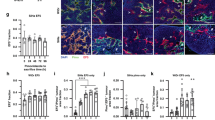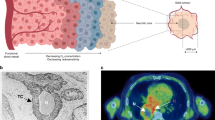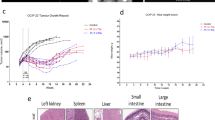Abstract
A panel of eight human pancreatic tumour cell lines displayed high intrinsic radioresistance, with mean inactivation doses between 2.4 and 6.5 Gy, similar to those reported for melanoma and glioblastoma. The radiosensitising potency of sodium nitroprusside, a bioreductive nitric oxide donor, was assessed in a model of metabolism-induced hypoxia in a cell micropellet. Sodium nitroprusside at 0.1 mM revealed a radiosensitising effect with an overall enhancement ratio of 1.9 compared with 2.5 for oxygen. Radiosensitising activity correlated with the enhancement of single-strand DNA breakage caused by radiation. In suspensions with cell densities of between 3% and 30% (v/v), the half-life of sodium nitroprusside decreased from 31 to 3.2 min, suggesting a value of around 1 min for micropellets. Despite this variation, the radiosensitising activity was similar in micropellets and in diluted cell suspensions. S-nitroso-L-glutathione was found to possess radiosensitising activity, consistent with a possible role of natural thiols in the storing of radiobiologically active nitric oxide adducts derived from sodium nitroprusside. As measured by a nitric oxide-specific microsensor, activation of sodium nitroprusside occurred by bioreduction, whereas S-nitroso-L-glutathione showed substantial spontaneous decomposition. Both agents appear to exert radiosensitising action through nitric oxide as its scavenging by carboxy phenyltetramethylimidazolineoxyl N-oxide (carboxy-PTI0) and oxyhaemoglobin resulted in attenuated radiosensitisation. Sodium nitroprusside was at least 10-fold more potent than etanidazole, a 2-nitroimidazole used as a reference. Our data suggest that sodium nitroprusside, a drug currently used for the treatment of hypertension, is a potential tumour radioresponse modifier.
This is a preview of subscription content, access via your institution
Access options
Subscribe to this journal
Receive 24 print issues and online access
$259.00 per year
only $10.79 per issue
Buy this article
- Purchase on Springer Link
- Instant access to full article PDF
Prices may be subject to local taxes which are calculated during checkout
Similar content being viewed by others
Author information
Authors and Affiliations
Rights and permissions
About this article
Cite this article
Verovski, V., Van den Berge, D., Soete, G. et al. Intrinsic radiosensitivity of human pancreatic tumour cells and the radiosensitising potency of the nitric oxide donor sodium nitroprusside. Br J Cancer 74, 1734–1742 (1996). https://doi.org/10.1038/bjc.1996.623
Issue Date:
DOI: https://doi.org/10.1038/bjc.1996.623
This article is cited by
-
Anti-apoptotic mechanism of Bacoside rich extract against reactive nitrogen species induced activation of iNOS/Bax/caspase 3 mediated apoptosis in L132 cell line
Cytotechnology (2014)
-
Nitric oxide: role in tumour biology and iNOS/NO-based anticancer therapies
Cancer Chemotherapy and Pharmacology (2011)
-
NF-κB inhibition impairs the radioresponse of hypoxic EMT-6 tumour cells through downregulation of inducible nitric oxide synthase
British Journal of Cancer (2003)
-
Tumour cell radiosensitization using constitutive (CMV) and radiation inducible (WAF1) promoters to drive the iNOS gene: a novel suicide gene therapy
Gene Therapy (2002)
-
Radiosensitization of hypoxic tumour cells by S-nitroso-N-acetylpenicillamine implicates a bioreductive mechanism of nitric oxide generation
British Journal of Cancer (1999)



